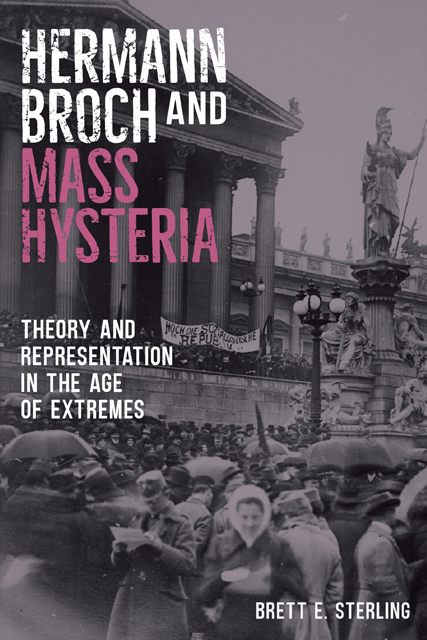Book contents
- Frontmatter
- Dedication
- Contents
- Acknowledgments
- List of Abbreviations
- Introduction
- 1: First Encounters, 1918–1929
- 2: The Power of Literature
- 3: The Mass Takes Shape: Literary Representations
- 4: Theory and Its Discontents: The Massenwahntheorie
- 5: The Threshold of Experience: Die Verzauberung
- Conclusion
- Bibliography
- Index
1: - First Encounters, 1918–1929
Published online by Cambridge University Press: 11 January 2023
- Frontmatter
- Dedication
- Contents
- Acknowledgments
- List of Abbreviations
- Introduction
- 1: First Encounters, 1918–1929
- 2: The Power of Literature
- 3: The Mass Takes Shape: Literary Representations
- 4: Theory and Its Discontents: The Massenwahntheorie
- 5: The Threshold of Experience: Die Verzauberung
- Conclusion
- Bibliography
- Index
Summary
On November 12, 1918, Hermann Broch was with his friends in the Café Herrenhof in Vienna, a favorite of Broch’s and the regular gathering place of a group of intellectuals and artists centered on author and critic Franz Blei. In advance of the planned proclamation of an Austrian Republic, huge masses of people crowded into the city center and moved toward the Parliament building. While his friends followed the crowd out into the street, Broch remained behind in the café. According to Gina Kaus, in his enthusiasm, Franz Werfel tore off his hat and shouted, “Nieder mit Habsburg! Hoch die Republik!” (Down with Habsburg! Long live the republic!). In the course of the day, the crowd of thousands gathered in central Vienna shifted from joy to panic when shots were fired. In the ensuing chaos, two people died and thirty more were seriously injured by the trampling mass. Far from sharing his friends’ optimism and enthusiasm, Broch viewed the mass event of November 12 with fear, disgust, and foreboding. In order to explain these feelings to his peers, he penned an open letter to Blei titled “Die Straße” (The Street).
This first engagement with the masses sparked a personal and professional preoccupation with mass phenomena that lasted until Broch’s death in 1951. Over a span of 33 years, crowds, mobs, and masses became fixtures of his work, both literary and theoretical. With the rise of National Socialism under Adolf Hitler and the outbreak of the Second World War in 1939, Broch’s fascination with mass phenomena took on a heightened importance as he endeavored to diagnose and analyze the scourge of mass hysteria that he saw driving fascism’s spread. His intended contribution to the fight against global fascism, the monumental Massenwahntheorie (Theory of Mass Hysteria), was tragically never finished, but it stands as a unique and compelling work of mass psychology.
In this chapter, I will examine Broch’s first recorded encounter with mass phenomena to establish a point of departure from which to trace the development of the concept of the mass and masses throughout his oeuvre, while situating him within the intellectual and political context of the time.
- Type
- Chapter
- Information
- Hermann Broch and Mass HysteriaTheory and Representation in the Age of Extremes, pp. 15 - 43Publisher: Boydell & BrewerPrint publication year: 2022



